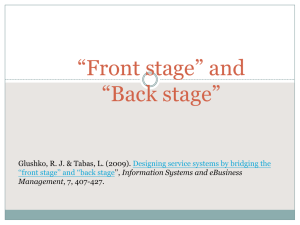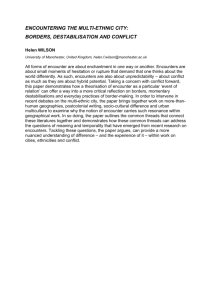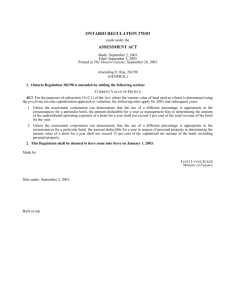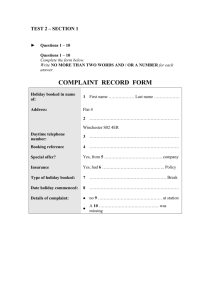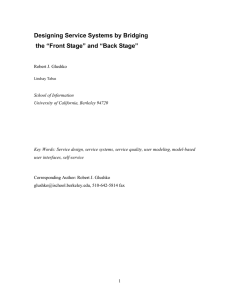Bridging the "Front Stage" and "Back Stage" in Service System Design
advertisement
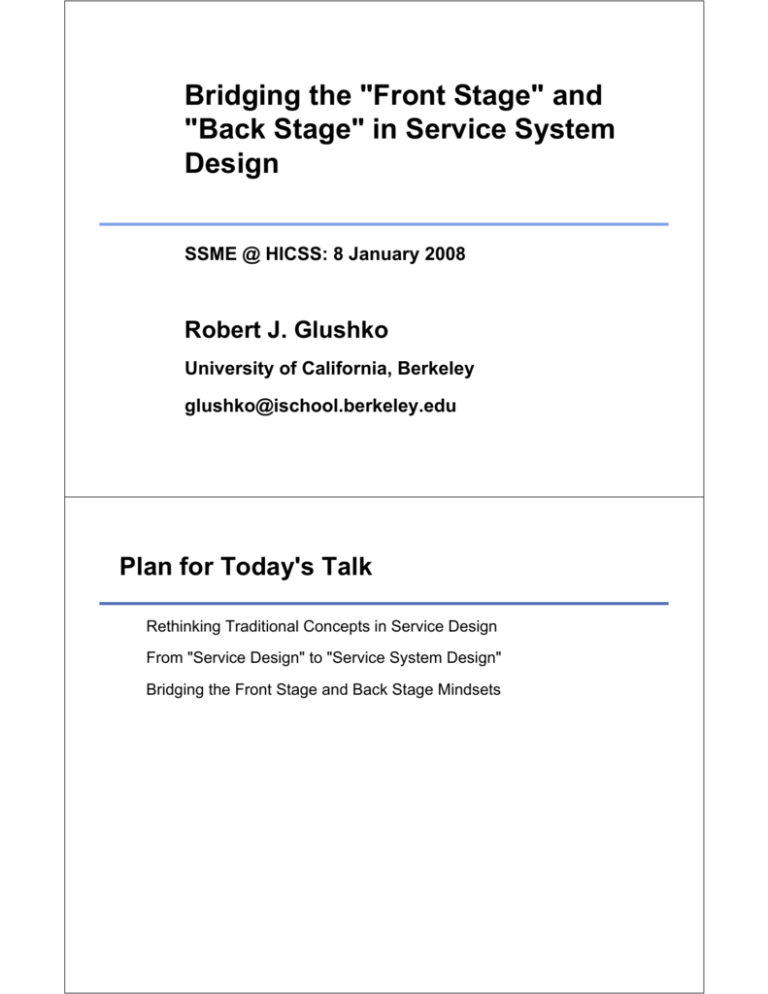
Bridging the "Front Stage" and "Back Stage" in Service System Design SSME @ HICSS: 8 January 2008 Robert J. Glushko University of California, Berkeley glushko@ischool.berkeley.edu Plan for Today's Talk Rethinking Traditional Concepts in Service Design From "Service Design" to "Service System Design" Bridging the Front Stage and Back Stage Mindsets The Traditional View of Services Traditional concepts of service management and design emphasize person to person interactions This approach focuses on the "touch points" or "encounters" where the service is delivered to the customer It emphasizes non-technological principles like empowering the employee, knowing the customer It de-emphasizes activities or processes that are invisible to the customer The Front Stage / Back Stage Distinction A focus on the service encounter implies a sharp distinction between the interactions between the customer and provider that are part of the service encounter and other activities that precede it to make it possible: The front stage represents the interaction the customer or service consumer has with the service The back stage is the part of the service value chain that the service consumer can't see Different "Lines of Visibility" -- Front / Back Stage Boundaries in Restaurants Radical Claims Start Here All of the concepts I've just mentioned need to be substantially rethought The "moment of truth" reveals service quality, but rarely determines it Front stage / back stage is not an architectural distinction It is just a point of view and bounded scope in a service system And it embodies some design biases that cause problems in service system design The Hotel Service Encounter What's the Quality of this Service Encounter? HOTEL RECEPTION EMPLOYEE: Welcome, Dr. Glushko, it is good to see you again. We know you like room 321, the corner room with the bridge view, so we’ve reserved it for you. And last fall when you were here you had us get some baseball game tickets because the Red Sox were in town, and it just happens that they’re playing again tomorrow night so we got some good seats for you. CUSTOMER: Thanks. What's the Quality of this Service Encounter? HOTEL RECEPTION EMPLOYEE: Last name? CUSTOMER: Glushko HOTEL RECEPTION EMPLOYEE: You're in room 321. Here's your key. CUSTOMER: Thanks. Simplistic View of Service Quality An Intense but Low Quality Encounter HOTEL RECEPTION EMPLOYEE: Your name, sir? CUSTOMER: Glushko HOTEL RECEPTION EMPLOYEE: I'm sorry, sir. We have no reservation under that name, and we're completely booked tonight. CUSTOMER: That's ridiculous. Here's my web confirmation page. HOTEL RECEPTION EMPLOYEE: I'm sorry, sir. We have no reservation for you. We are profoundly sorry. Why don't you wait in the lounge while we call one of our partner hotels and get a room for you... CUSTOMER: This is completely incompetent. I'm tired... HOTEL RECEPTION EMPLOYEE: I'm sorry, sir. We will pay for your room tonight at our partner hotel or give you a voucher for a free night here on your next stay. Self-Service Hotel Check-In What's the Quality of this Service Encounter? AUTOMATED CHECK-IN SERVICE: Please insert your credit card CUSTOMER: (Inserts credit card) AUTOMATED CHECK-IN SERVICE: (issues digital key card) Room 321. Here's your key. The Four Service Encounters in the Hotel Service System We Might Focus on How These Differ... Employee to Customer Service B2C / Self-Service Intra-enterprise / Business to Employee Services Inter-enterprise / B2B / "Web Services" Or Focus on What They Have in Common: There are service producers and service consumers Each service provider has an interface through which the service consumer interacts to request or obtain the service Value or quality is created/co-created by the interactions and interchanges between the provider and consumer Quality in the Hotel Check-In Service System There may be a “moment of truth” at the time of check-in when the quality of the service experience becomes apparent to the customer, but that quality is enabled or constrained by all of the service encounters ...even though many of these encounters don't involve or are invisible to the customer, and some of them are even invisible to the hotel employees So we need to take a comprehensive and "end-to-end" view of how a service is defined and delivered Service Encounters are Information Exchanges For many services, especially those with a significant technology / information component, the information exchanged through the service interface is the primary determinant of the value received or experienced by or co-created with the service consumer Treating ALL service encounters abstractly as information exchanges highlights the inputs and outputs and the choreography with which the provider and consumer exchange information to initiate and deliver the service This perspective de-emphasizes the obvious differences between person-to-person services and computational or automated ones From "Service" to "Service Systems" This unifying abstraction of service encounters as information exchanges gets us to the SERVICE SYSTEM as the appropriate framework or perspective for understanding how services work It also makes it much easier to consider alternative service system designs: replacing or augmenting a person-to-person service with self-service substituting one service provider for another in the same role (e.g, through outsourcing) eliminating a person-to-person interaction with automation "Service System" Definition (Glushko) A set of interconnected provider-consumer relationships and the flow of information through them A set of related services can define a SERVICE CHAIN or SERVICE NETWORK or VALUE CHAIN Designating the last consumer in a service chain as the POINT OF VIEW establishes a perspective or context in the service system Visualizing a Service System A Point of View in a Service System Same POV with a Different Scope Different POV Visualizing the Front and Back Stages Front and Back Stages with Different POV Front Stage and Back Stage Inversion Bridging the Front Stage and Back Stage in Service Design Front stage / back stage is not an architectural distinction It is just a point of view and bounded scope in a service system And it embodies some design biases that cause problems in service system design But if we design the service system as a whole rather than as front stage + back stage, we can overcome these problems Contrasting Design Goals Resolving the Tension: Bridging the Back Stage and Front Stage The tensions between the back stage front stage are not intrinsic and unavoidable; they are just a consequence of too narrow a design perspective "Merging the mindsets" with multidisciplinary design teams is an obvious and necessary correction, but it is not sufficient We need a methodology for designing service systems that cuts through these mindsets Design the Service System! Create information flow and process models that span both the back and front stages, and exploit design patterns when appropriate Implement "model-based user interfaces" Design services to be modular and configurable ... to enable them to be easily substituted for ... to enable them to be easily made visible or invisible to other parts of the service system Information Flow and Process Models that Span the Service System We have many useful modeling methods and frameworks for designing service systems: supply chains, marketplaces, demand management, queuing theory, etc. Many of these can be used to ensure some level of service quality by balancing capacity and demand in a coarse or aggregate manner Other modeling approaches (e.g. data mining, business intelligence, intelligent dispatch) can shape service quality or experience for specific customers (e.g., personalization systems, customer selection for service) But many service systems that we want to analyze are so complex that we need to rely on more qualitative approaches Who "Drives the Model" as a Service System Design Choice The same model can often be driven or exploited by either the service provider or the service consumer; this is a design choice in the service system Use a user profile for a recommender system (provider driven) or to drive a consumer agent A "Service Level Agreement" can be defined in either provider or consumer terms What is the relationship between "actors in use cases" (back stage mindset) and "personas" (front stage mindset)? Where Does the Information Required for Personalization Come From? From the consumer: Surveys and forms Transactional records Behavioral records, navigation history From data brokers, using keys obtained from the consumer From other consumers who are similar to the target consumer Asking a Personalization Design Question in a "Service System Way" Is it more intense to ask the customer questions at the front desk, or to fill out a self-service form? It is more intense to ask the customer to complete one complicated form or several simple ones over time? Instead of asking at the front desk or requiring the customer to fill out the form, can we use information we already have (from previous encounters, from other contexts, from aggregated business intelligence) to make it unnecessary to collect information from the customer? Summary Traditional concepts in service design -- the moment of truth, the front stage / back stage distinction -- don't always help us understand today's more information-intensive and multichannel service systems We need a methodology for designing service systems that takes a more horizontal or "end-to-end" view The idea that all services can be viewed abstractly as information exchanges is a key part of this new approach

